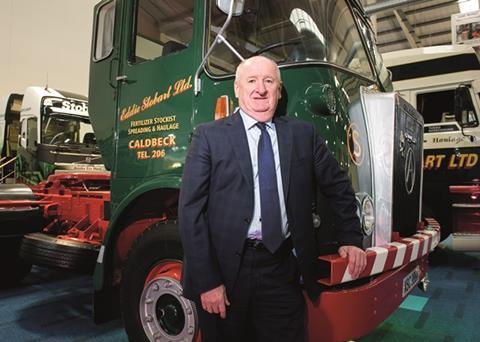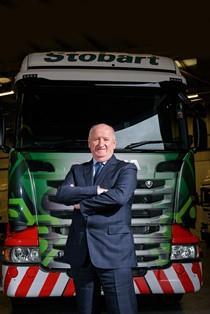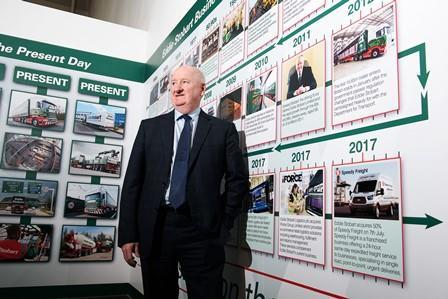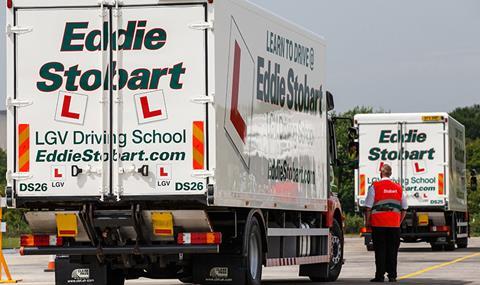
Alex Laffey was 25 years with Tesco before becoming CEO of Eddie Stobart Logistics (ESL) in May 2015 in preparation for floating the business of the Alternative Investment Market (AIM) of the London Stock Exchange in April 2017.
Just before the listing William Stobart stood down as a director and the flotation broke the link with the Stobart Group, which is listed on the main Stock Exchange, and gave Isle of Man based private equity firm Douglas Bay (DBAY) an exit route from the business.
“In 2014 Stobart Group sold down control of ESL to DBAY and I knew when I joined the business their horizon was three to five years,” says Laffey. “We set about putting the business in the best possible financial shape and being listed on AIM achieves that goal.”
William Stobart remains on a retainer, helping to look after the transport fleet, but ESL is no longer a Stobart family firm. “William has been in transport all his days and I would be crazy not to use his expertise when it comes to innovation and design,” says Laffey. “On day one when I walked into the company I was impressed with the culture. We’ve worked hard to make sure we don’t lose that and I am always accessible to staff.”
Stobart Group, now an infrastructure, energy and aviation services business, had owned almost half of ESL and realised £120m from the flotation while retaining 12.5% of ESL and ownership of two of its sites. The float also raised £130m for ESL which, according to the prospectus, will be “used primarily to reduce gearing, partially fund the acquisition of iForce Group and provide ESL with a financial platform to support its growth ambitions”.
Double digit growth
Laffey declines to put a number on those growth ambitions but confirms he is looking to maintain “double digit” annual increases in revenue. “What we have is working in the market place but if we don’t innovate, don’t deliver the service and aren’t competitive, we won’t grow,” he says. “It is up to me to describe the value we can bring to organisations - and then deliver it.”
Since the float, the ESL share price has had a bumpy ride, and at the time of our interview in early December 2017 was 5p off the 160p float price at 155p.
Laffey is a down-to-earth Geordie who would rather spend his time running the company than in the City. But he is keenly aware of the importance of a healthy share price, and our meeting is in a smart London restaurant ahead of a day of investor and broker briefings.
“I don’t spend all my time looking over my shoulder at the share price,” Laffey says. “The focus is doing the right thing within the business. The share price will look after itself if we do that.”
Laffey is surprised that the share price hasn’t done better, bearing in mind an excellent set of half-year results for the six months to May 2017, with underlying revenue excluding its discontinued Irish operation up 13% to £286.8m and underlying pre-tax profit increasing 14% to £16.9m. The company also put out a bullish trading update in July, saying operational efficiencies had seen “modestly expanded” profit margins and that “operations continue to trade well as we move into the second half of the financial year, and we look forward to delivering a full year performance in line with market expectations”.
Acquisitions
The flotation helped fund three acquisitions – 100% of e-fulfilment specialist iForce, 50% of same day courier Speedy Freight and the remaining 50% of recruitment business The Logistics People – to expand ESL’s capabilities beyond its core trucks and sheds, and Laffey says further acquisitions are on the cards.
“Our strategy is acquisitive and both iForce and Speedy Freight add to our capability,” says Laffey. “IForce is a specialist operator in e-commerce, which is growing as bricks and mortar sales are cannibalised by online, while Speedy Freight’s sweet spot is urgent B2B same-day or next-day cargo. It tends to be one or two pallets and if it’s more than that they will pass it to Stobart.”
IForce provides e-fulfilment services including returns management for a wide range of retailers including John Lewis, Maplin and Cath Kidston. It was in the vanguard of online, sending out John Lewis’s first ever online order back in 2003. It operates from eight leased multi-user sites with 1.5m ft2 of warehousing space and is ‘implanted’ into two customer DCs where it handles the e-commerce channel from mezzanine floors above the main store distribution operation.
“IForce delivers e-com services for a diverse range of customers and handles everything from a jacket for John Lewis through to plants and furnishings,” says Laffey. “If you order a John Lewis jacket you may click on a John Lewis website but immediately behind that your order will start to be processed in an iForce distribution centre.
“They select the carrier, inject it into the courier network and track it to your front door. If you don’t want the item, iForce will handle the reverse logistics back to the DC. If given the OK by the customer it can then sell products online but it never owns inventory.”

ESL does not do final mile deliveries but the green and white trucks do ‘middle mile’ for several home delivery operators. IForce has no transport and Laffey is keen for the two companies to exploit the opportunities for cross-selling.
“We have had some success providing transport to iForce customers,” he says. “We are also working with a number of couriers to support them. ESL has 47,000 vehicle movements a week and we are networking them to reduce road miles. That gives us a competitive advantage which we are pushing into the marketplace.”
Laffey says the iForce network is at capacity and will need to grow, including exploiting opportunities for the e-commerce business to share ESL sites.
“Because of the operating models, putting iForce into an ESL DC is absolutely the right thing to do,” he says. “They can operate on mezzanines so we can leverage the footprint much better than we do today, add real value to the customer and deliver real value to our shareholders.”
While Laffey currently has no intention of getting into the ultra-competitive B2C final mile home delivery business, he says “never say never”: “Maybe a white glove, high end service – but we have no plans for that at the minute. The nearest we get to final mile is Speedy Freight and that is all B2B.”
Speedy Freight is in 41 locations but does not own any vehicles, preferring to use local owner drivers. ESL also operates an asset light model, renting its 28 UK sites and leasing all of its vehicles and equipment.
“It gives us flexibility,” says Laffey. “The market tends to work to five years but we think two to three years is the sensible life of a vehicle and when we can dispose of it at its highest residual.
“But the real reason is flexibility. On Christmas Eve 2016 we defleeted 347 trucks because January and February are quieter months. In the past three weeks [in November 2017] we have put on way over 200. If we were going to dispose of a vehicle in year three we can run it on for three or six months if we need it short term.”
Vehicle performance
By timing the arrival and departure of vehicles to coincide with seasonal peaks and troughs ESL also avoids using expensive short term rental.
Historically ESL has had a long-standing joint vehicle purchase deal with AW Jenkinson, splitting the majority of their annual order of almost 1,000 trucks between Scania and Volvo. When asked about the relationship with Jenkinson Laffey says: “There isn't one really. Alan Jenkinson works on biomass so he is working more with Stobart Group. We do some joint buying but it's not significant.”
The preference for the Swedish brands is due to an analysis of running costs and total cost of ownership as well as driver feedback.
“That is down to the performance of the vehicle,” says Laffey. “William [Stobart] and his team has benchmarked all the vehicles just like I used to do at Tesco.”
At Tesco of course Laffey bought mainly Mercedes-Benz but says secondary distribution to stores is a very different job to that done by a 3PL like ESL. “The sleeper cabs on the Tesco fleet will never be used,” he says. “They were on the vehicle only for residuals. It costs £900 to put on a sleeper cab and you get more than that back when you put it on the market. But we are not a truck dealer, we are a logistics company. If there is an upside on the residual it is in the next lease.”
“We have worked our way through all the different vehicles. Today we are running Scania, Volvo, and Mercedes. Different vehicles perform better at some jobs and we use Mercedes on some of our specialist contracts like motorsport and for low-ride vehicles in Europe.”
Even though confusion remains over the future of trading relations between the UK and the EU post Brexit, Laffey also wants to grow the Eddie Stobart brand on the continent. He says for his customers it is “business as normal” for the time being as everyone watches the negotiations between the UK and the EU.
Active in Europe
Despite selling up its UK automotive transport operation because Laffey felt it was not an area the company could grow, ESL retained the European business. It also has a continental general cargo business working for UK as well as European customers – Laffey worked in several European markets while at Tesco.
“We are active there now, with 200 trucks operating across Europe,” he says. “It represents just less than 10% of our revenue and we want more of a presence in Europe, including some warehousing footprint which we haven’t got. We can do that ourselves and will continue to balance acquisition and investing in the network. I’m aware of the challenges in Europe and we will always have local expertise on the ground.”
Acquisitions would have to add something that the company doesn’t already do for itself. “We run the most modern fleet in the UK and we use the best technology,” says Laffey. “Unless it was bringing some sort of specialism to ESL and giving us a skill that enhances our credibility, capability and scalability then I don’t think bog standard transport is where we want to be buying.”
Growing while maintaining ESL’s enviable 7.5% operating margin will be the challenge, and continuing to improve the fleet’s utilisation will be key.
“If you go back to the historical legacy of the business, it was in two sectors: retail and consumer,” explains Laffey. “They peak and trough together so if you are putting assets into those two areas you will either be flat out or looking for work. So we have added two further sectors which are complementary: e-com, and manufacturing, industrial and bulk.
“I worked in retail for 30 years and it is 24/7, but ambient products move through the day and fresh products through the night. In e-com it all moves through the night so we have a pool of assets we can deploy into those other sectors because manufacturing and industrial still operates through the day.
"Before Christmas, retail, consumer and e-com are flat out just as manufacturing and industrial starts to close down. That means we are nothing like as reliant on subcontractors as we were back in 2014 because we have a much more self-sufficient and sustainable model. Year round only 5% or 10% of our volumes are subcontracted. It is slightly higher at peak but not much.
“This pay-as-you-go model is why we are able to deliver the performance we do.”
Traffic regions
In practice, ESL breaks the UK down into a number of traffic regions and tracks every vehicle moving within and between each region.
“We know what we have going into and out of every traffic region,” says Laffey. “We can see how good a fit any new piece of work is, and our job is to thread it together. It relies on skilled people and the functionality of our systems.”
ESL's empty running is already “much lower” than the national average of 30% (DfT statistics for 2016) and Laffey says the company is “investing in developing further levels of optimisation to make us even more agile”.
“We are sub-20%,” he says. “The sweet spot is between 10% and 20%. If we go much lower than that it will have an impact on our service levels. There is little bit more to go at but we are close to that sweet spot.”
Laffey wants to offer more services to new and existing customers, outside ESL’s traditional primary full trailer load trunking.
“I want to give customers a full service offering, not just transport,” he says. “That includes warehousing (dedicated and multi-user), container inbound, e-com etc. The job starts when we win the customer, and if we are not delivering our full proposition and looking for further value the next time they come to retender it, we will be climbing a hill.
“I want to build long term, strategic relationships with customers, not short term tactical ones. 'Good' looks like helping them with services right across the supply chain and they see us as the go-to organisation. We have no right to that relationship – we have to earn it.”
People v technology
Profitability is also about running a highly efficient operation, and Laffey says that is down to a combination of having the best people and the right technology.
“First and foremost it is about the skills of the people, and then they couldn’t do it without technology because that is a huge enabler,” he says. “We’ve brought a lot of new people into the business, skilled practitioners in the newer sectors.
“It also about equipment innovation. We are always looking for the best piece of equipment to do a job. Double deck trailers have evolved in recent years for example. Years ago they didn’t have double the carrying capacity of single deckers but today they have.
“We are continually innovating. An Eddie Stobart curtainsider might look like a standard trailer but if you pull the curtain back it is flexible and because of our strapping systems it can carry pallets one day and blocks the next. We are also using articulated cement mixers that significantly increase cubic capacity.”
Flexibility is also improved by the fact that hardly any of ESL’s trucks are in customer livery, meaning “we can go anywhere” says Laffey.
“A truck with a retailer’s brand on it cannot go into another retailer’s premises,” he argues. “We have a universal currency because 98% of our trucks are in Eddie Stobart colours. Some of our bigger competitors are driving trucks that belong to retailers and they are in their livery.”

Eight of ESL’s 28 sites are dedicated rather than multi-user, but the haulier no longer runs any Tesco DCs. “We do some storage and operate transport for Tesco but I believe Tesco runs most of their DCs now,” says Laffey. “I designed that network but I am no longer that close to it. They use our transport because they only pay us when they need us. Our network is how we manage that for them and many other customers.”
Since Laffey’s arrival, the proportion of ESL’s revenue coming from Tesco has declined from 34% in 2014 to about 20% now. “Every customer large or small is important and our relationship with Tesco is no different to any other. I always say a small customer is the next big customer,” he says. “We have grown other sectors of our business strongly and brought balance rather than losing work from Tesco.
“We are only as good as our last delivery and we work hard to deliver the service levels we have committed to but also innovate beyond that.”
Temperature controlled
Five years ago Eddie Stobart closed the loss-making chilled distribution business it acquired from Innovate back in 2008, but it still runs a significant temperature controlled operation for food manufacturers in South Yorkshire and the Midlands with 7 million sq ft of space currently and plans to expand each year. Services include up to five days storage for yellow fats and cheese and cross docking of shorter life products such as fresh meat, and the fleet includes a number of multiple temperature trailers.
“Chilled operations are good if they are less than truckload and we are carrying multiple customers’ product on the vehicle,” says Laffey. “I have the greatest respect for organisations like Turners and Fowler Welch but we run a very good chilled business which is not something we are famous for. It is not as big as it needs to be and we will continue to invest in it.”
That investment includes recently converting a Lutterworth DC into a chilled facility to service a new customer contract.
Another specialist business that Laffey sees potential to grow is petrol delivery. ESL now runs 50 petroleum tankers, 18 of which are on a contract in Ireland. “It's an area we do well and can grow,” he says.
Working out which customer segments are most profitable and so should grow fastest is difficult as vehicles and assets are shared across the network. “It depends where we apportion the cost,” says Laffey. “A truck might be working for construction in the morning and e-com in the afternoon and we are working on that. In terms of revenue we are seeing good growth across the piece but the best growth is in e-com at the minute.”
Delivering Sustainable Distribution
Many of Eddie Stobart's green and white trailers proudly state 'Delivering Sustainable Distribution', a questionable claim bearing in mind it is being pulled by a non-recyclable tractor burning non-renewable fossil fuels at the rate of 10mpg.
While Laffey accepts that diesel is not a truly sustainable fuel he argues that modern trucks remain the most efficient means of delivering the goods.
“Where is the viable alternative at the moment?” he asks. “Our fleet is 100% Euro-6 with the cleanest engines. We continue to look for alternative fuels but all these technologies still have issues to iron out. Sustainable means we run the fewest miles to deliver because of our network on the cleanest vehicles.
“And we run trains from Daventry to all points south west, south east and north west – not quite north east yet because there isn't the traffic, though we do go to Aberdeen via Glasgow. We have a rail terminal in Widnes and take containers in there by train from Felixstowe. We run our own trains and dedicated trains for the likes of Tesco which we have done for around 10 years.”
As well as conventional boxes ESL uses its own design of low height containers on rail so its trains can divert around any hold ups on main lines.
“Rail is still not that competitive with road,” says Laffey. “We compare rail with doubledecks and we can just about make trains competitive. It is still relatively small and it needs a lot more work.”
Working for Britain’s most famous haulier
ESL has always had a loyal fan base of ‘Stobart spotters’ but the company and its uniformed drivers were brought to an even wider audience with the Channel 4 documentary series 'Eddie Stobart: Trucks and Trailers'.

But that does not mean the company can just sit and wait for drivers to form an orderly queue for jobs and it is actively recruiting and training drivers in its impressive Driver Training School and Training Academy based at its Appleton head office, a new facility in Rugby and a site to be announced in the South of England. It has also acquired 100% of leading recruitment firm The Logistics People to give ESL “surety of supply”.
“We are in a relatively good place with staff; at the moment we are 80/20 employed/casual labour,” Laffey says. “We are saying to customers ‘don’t just assume we will be there to pick up 100 loads – give us as much information as you can’. The workforce is more transient and there is more work to do by everyone but right now we are in reasonable shape.”
Laffey says that the biggest challenge the company faced in recruitment was in 2014 when the Driver CPC prompted around 5% of HGV drivers to switch to light commercials. “That put the industry under a lot of stress, but has now been corrected by the industry investing in training,” says Laffey. “There is more to do and we moved our academy on significantly in the past two years.”
What has changed is that ESL has opened up its training facilities to third parties and plans to make it a significant revenue stream.
“Training has always been an important part of the business and it will become a bigger part of what we do,” Laffey says. “We have taken that to the market and customers and competitors have expressed an interest in using it.”
While Eddie Stobart does not fund new drivers to obtain their HGV licences, finance is available and it gives every successful driver an interview for a full time driving job with ESL.
“We are offering licence acquisition and we have arranged funding for that,” says Laffey. “If people stay beyond a certain period of time we will wipe out that debt. The Apprenticeship Levy helps and we as an industry need to engage with government to ensure that money is spent better. We need the associations and the media to help with that.”
When the business listed, every employee was given a share in a move reminiscent of the privatisation of NFC in 1982. “When we floated, I insisted that the outgoing investors left a chunk of money on the table for staff,” says Laffey. “Every single employee was awarded shares depending on their length of service. The Eddie Stobart business is nothing without its people. So I am looking for buy-in and commitment and giving them shares is part of that. The rest is giving people the opportunity to progress in the business which we are doing.”
- Eddie Stobart more than doubled its e-commerce turnover last year after the acquisition of iForce. Read the full story.













